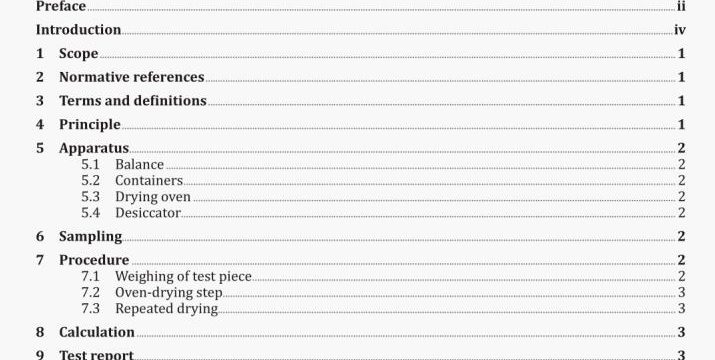AS 1301.457-2020 pdf download.Methods of test for pulp and paper
Method 457: Determination of moisture content in paper, board and pulps.
Containers for preventing changes in moisture content during the transporting and weighing of test pieces, having airtight lids or other equivalent means of sealing, and made from a lightweight material not subject to change under conditions of drying specified in this document. Where test pieces are taken according to AS/NZS 1301.417s, the containers need to be large enough to contain sheets without cutting or tearing them. Before using a container, determine its tare weight.
5.3 Drying oven
A drying oven capable of being maintained at an air temperature of 105 ± 2 °C in the usable volume and having forced ventilation.
5.4 Desiccator
A dessicator equipped with freshly dried desiccant.
6 Sampling
Take a sample which is representative of the paper, board or pulp the moisture content of which is to be determined.
Two standard sampling procedures for determining the moisture content of a lot exist, although any alternative procedure may be followed
NOTE When the purpose is to obtain test pieces from a lot of paper or board, AS/NZS 1301.417s may be followed. When the purpose is to obtain test pieces from a lot of pulp in bale or roll form, AS/NZS ISO 7213 may be followed.
Throughout the chosen sampling procedure, minimize the chance of the sampled material losing or gaining moisture in exchange with the ambient air by wrapping the sample. Avoid moisture gain of the sampled material from contact with the skin by wearing gloves.
Take sufficient sample material to ensure that the mass of moisture in a test piece can be determined to within 0.05 % of the mass of the test piece and so that additional test pieces can be obtained to permit the performance of replicate measurements if required. Enclose each test piece in a tared dry container (see Clause 5.2).
7 Procedure
7.1 Weighing of test piece
If the test piece is hot when taken, allow to cool and equalize the air pressures inside and outside the container by momentarily opening and reclosing the lid immediately before weighing. Weigh the test piece in its container.
7.2 Oven-drying step
Dry the test piece in the oven, either in its container (with the lid removed), or taken from the container and spread out to expose the maximum surface area. If the nature of the test piece is such that removal from the container could result in hbre or other solids being lost, it shall be dried in the container.
If the test piece is taken from its container, dry the container and lid under the same conditions.
When the test piece is considered to be completely dry (allow at least one hour), prepare to transfer it to the desiccator. If the test piece has been removed from its container, replace it in the container and fit the lid loosely before the transfer. If the test piece has been in its container during the drying period, fit the lid loosely. The transfer shall be done promptly to minimize exposure of the test piece to the atmosphere outside the oven.
Allow the container to cool in the desiccator. As soon as the container is cool enough so that the potential reduction of pressure in the container resulting from continued cooling does not risk sucking moisture- laden air into the container, properly fit the lid while still in the desiccator.
Remove the assembled container and its contents from the desiccator and weigh.
7.3 Repeated drying
Replace the container and test piece in the oven as described above and dry for a further period of at least 30 mm. Cool and reweigh the container and test piece as described in Clause 7.2.
If necessary repeat this, until consecutive weighings do not differ by more than 0.1 % of the initial moist mass of the test piece.
8 Calculation
Calculate the percent moisture content from the loss of mass and the original moist mass of the test piece to the nearest 0.1 % by the following formula:AS 1301.457-2020 pdf download.Methods of test for pulp and paper
Methods of test for pulp and paper
